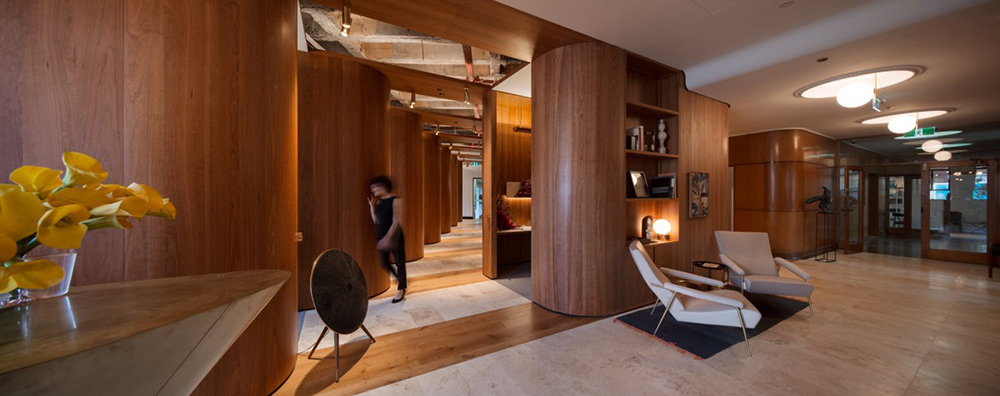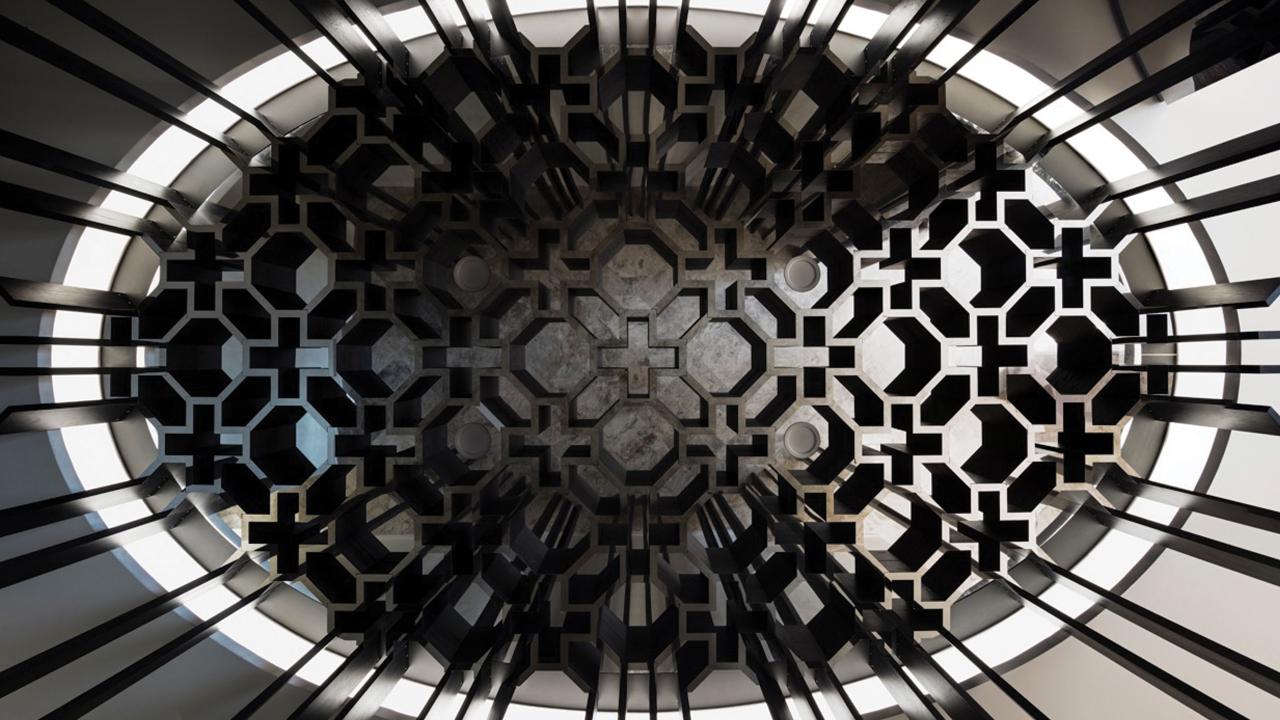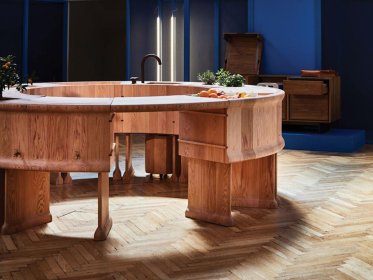
The bar cabinet at Paramount by The Office Space featuring American cherry and brass inlays, how good would that look at home... Photograph by Trevor Mein
From cabinets to kitchens and entire rooms, timber joinery is becoming increasingly popular and, as designers, builders or home renovators, it is important to understand what species of hardwood are best suited to the rigours of detailing and everyday use.
Co-working spaces are the home-away-from-home for many travelling professionals and the Paramount by The Office Space within Sydney’s Paramount House by Woods Bagot and Elan Construction is one of the world’s most sophisticated of its type. While we all like to leave our work at work, the take-home from this workspace, what makes this relevant in a residential context, is sense of luxury created through the joinery, the choice of timber and the way it was constructed.

The interior of Paramount by The Office Space is formed from American black cherry veneer.
Todd Hammond, Woods Bagot former Head of Interiors (now director of Hammond Studio), says the intention was to create a space 'seemingly milled from timber to reconstruct a "yesteryear" aesthetic in contemporary presentation.' Thus, the softly curved office suites are formed from American black cherry, a species that he says offers an alternative to the ubiquitous trend in Australia for blond timbers, yet without the formality of darker walnut. 'I think cherry sits somewhere in between; not only in tone but also with its level of professionalism, which can be used in a casual way.' Indeed, whilst walnut was considered for its sense of luxury, it was felt the darker hue would enclose the smaller offices and American cherry offered the golden, honey tone that complemented the Queensland maple timber that graces the entrance to the space.
Paramount by The Office Space is owned by Director of Elan Construct, Boris Tosic, who decided to approach the build as a joinery exercise, which meant resolving the design and creating most of the structures in the Elan workshop itself. 'We levelled the floor and then staged out the site to the millimetre with timber stencils and different elevations to reveal where the suites would sit. The curved suites were then constructed entirely by hand in our workshop before being transported and set in place. It is essentially a giant 3D puzzle that clips onto itself.'
This is akin to the way we are seeing modular homes made, prefabricated and shipped to the location, though it is interesting to consider the potential in residential interiors. The build included hand-glued American cherry veneers, mismatched and rotated and the interior carcasses of the kitchen cupboards feature cherry and brass detailing. A result that would not have been possible without the combination of contemporary CNC technology, bespoke joinery and shipbuilding techniques, in addition to a hand finish and all done off-site.

The ceiling joinery of the Lucia apartments in American white oak by Cristian Cole.
Another puzzling piece of joinery is the 2.5 ton American white oak ceiling feature in the lobby of the South Yarra Lucia apartments building by Christian Cole. Whilst probably best known for his furniture, aided perhaps by the regular featuring of his work on Nine’s The Block, Cole claims he likes to challenge himself and the ceiling designed by Elenberg Fraser Architects provided one such challenge – taking over eight weeks to install by Cole and his team. Christian persuaded the designers to consider American white oak given its superior stability.
Cole’s sculptural ceiling may be a little over the top for an apartment or home, his selection of timber is worth noting, 'I think it’s a species thing and also an American thing,' he says. 'Americans dry their timber better. It’s really stable and doesn’t expand and contract much.'
Also familiar to those with an eye on the design media is designer Greg Natale who also sees the advantages of American oaks. 'At the moment we’re using a lot of timber in homes,' he says. 'But we stain and lacquer it. The American oaks are particularly good for that because they have such a strong and distinctive grain – you need a heavy grain if you’re going to stain wood. We’re looking at using more American red oak,' he says. 'It accepts stain so well because it’s a more porous wood. It looks beautiful but still it’s really durable,' he explains.
So, how do we select the right timber for a project? Louise Ommundson of Sydney’s Evostyle tells us, 'A comprehensive understanding of the natural growth characteristics and material behaviour of timber is essential in successfully designing, specifying and constructing with timber.'
One of the key aspects is how the timber is dried and Ommundson advises that all timber used in joinery should be kiln dried to a moisture content of between 9 and 14%, in accordance with AS 2796, increasing its dimensional stability, strength, stiffness and durability. Even with appropriate drying, timber still moves, absorbs moisture and dries out – a factor that can be compensated for through correct detailing.
Having produced furniture and fit-outs for Australia’s leading designers, Evostyle knows a thing or two about timber and recommends the best species of timber for furniture and joinery are:
American Hardwoods – including white and red oak, black walnut, ash, rock maple, cherry, hard maple
Australian Hardwoods – spotted gum, blackbutt, chestnut, Victorian ash, Tasmanian oak
European Timbers – European beech, European oak
Below we outline the key factors that Louise sees as important in selecting the right timber, though as an overarching approach she says, 'Each timber species has unique characteristics and should be selected with both the design intent and suitability for the application in mind. For example, it is no use selecting a timber species that is not readily available, or that is too soft for the application you require or is too expensive to be viable.'
_
HOUSELAB HINTS
It is important to discuss the selection of timber with a timber supplier or joiner prior to finalising any design as they will be able to advise on the following considerations:
1. Considerations for selecting Timber species
- Colour
- Grain
- Shrinkage
- Hardness
- Durability
- Workability (machining, nailing, screwing, gluing)
- Availability
- Price
- Sustainability
2. Considerations for Solid Timber Detailing
- Determine application (e.g. indoor or outdoor)
- Determine preferred timber species
- Consider durability required
- Consider level of maintenance required
- Consider cost (initial and ongoing maintenance)
3. Apply correct detailing to match species and allow for natural movement
4. Determine preferred finish
- To suit application
- Design preference
- Ongoing maintenance by end user
Click here for more information on American Hardwoods
WRITTEN BY HouseLab








